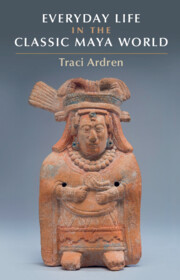4 - Into the City
Published online by Cambridge University Press: 01 June 2023
Summary
The landscape in Classic Maya times was a patchwork of large areas of sparsely settled agricultural production interspersed with chaotic and sprawling urban centers of varying size. Urbanism has been long debated in Maya studies but is usefully defined as a measure of geographical size, density of occupation, and range of social differentiation.1 Much of what we know about ancient Maya culture comes from the investigation of large cities (anywhere from 3 to 60 square kilometers of settlement with populations estimated to be from 5,000 to 60,000 people at a time)2 where elites ruled and daily life was filled with the spectacle and hardship to be found in any city. Crowded and noisy, but cleaner and more beautiful than the ancient cities of Europe according to firsthand accounts by Spanish explorers, each Maya city was unique. There was no template for how a city was designed, and they grew in what appears to be a haphazard manner, according to the changing fortunes of their leaders and economies. Recently, the idea of “low-density, agro-urbanism” has been applied to Maya cities, and they may have grown according to the environmental and farming potential of different neighborhoods. This would be an energy-efficient way to produce food close to consumers, especially in the absence of wheeled transport or pack animals.3 As in all cities, a great diversity of activities took place on a daily basis – from marketing to construction to performance. Literacy was available to some members of Maya urban centers. It was practiced by scribes and other professionals who studied how to write complicated hieroglyphic inscriptions, by craftspeople who carved texts into stone or wood, and by the members of royal families who consulted books and commissioned monuments to celebrate their accomplishments. Maya cities had ball courts, a central institution of elite culture where men competed against rivals in a reenactment of a mythological cycle that encapsulated the core values of Maya people. New research shows Maya cities had central markets where the goods and crafts produced in small households described in earlier chapters were exchanged or bartered among all levels of society. Often seen as an urban culture, it was the interplay of rural and urban that made city life possible.
- Type
- Chapter
- Information
- Everyday Life in the Classic Maya World , pp. 69 - 93Publisher: Cambridge University PressPrint publication year: 2023



